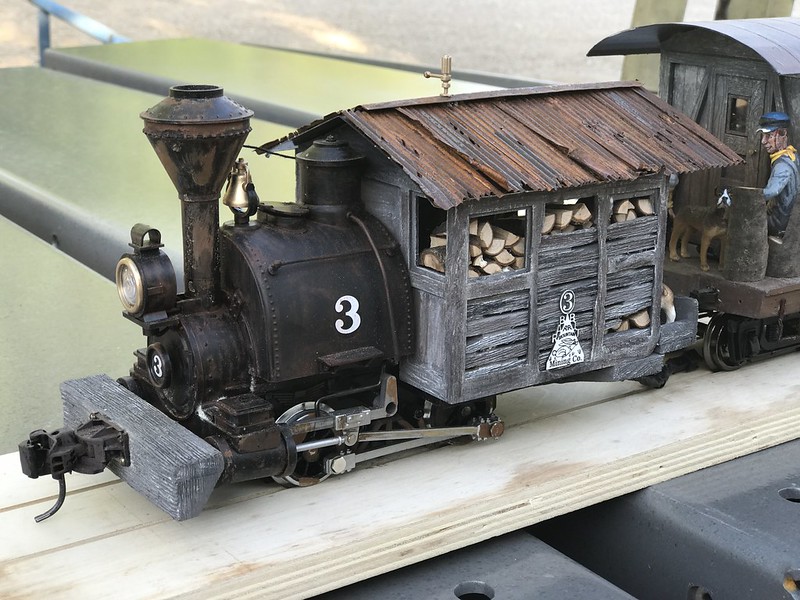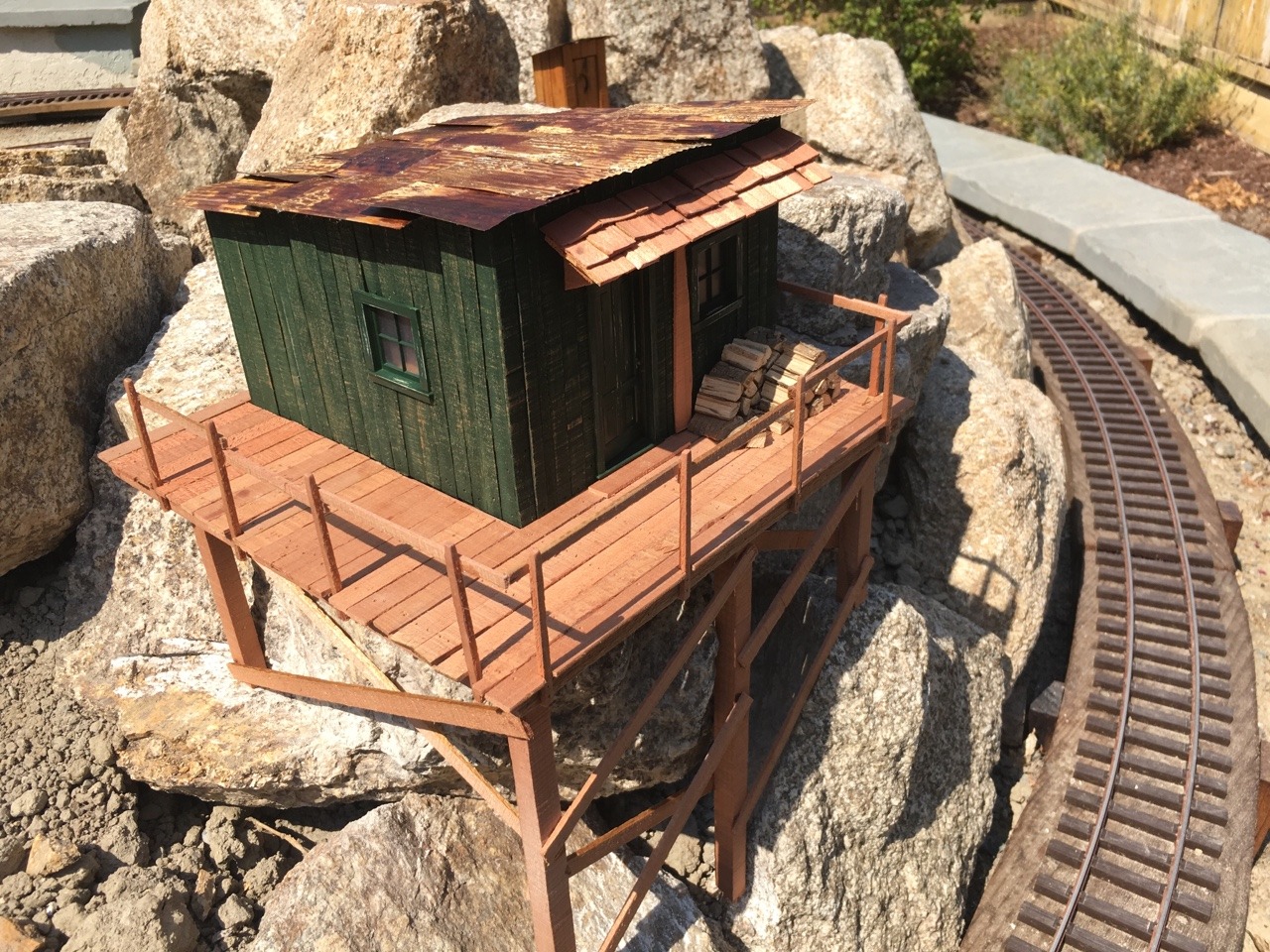 I’ll print out the sign for ya…(https://www.largescalecentral.com/externals/tinymce/plugins/emoticons/img/smiley-wink.gif)
I’ll print out the sign for ya…(https://www.largescalecentral.com/externals/tinymce/plugins/emoticons/img/smiley-wink.gif)
These tanks I posted earlier are not the tanks in the front of the feed mill. Those tanks in front are about 45 feet tall and hold about 3 tons of feed each.

Can you spot where these are? They are “only” 37 scale feet tall. Made from 3" ABS pipe. They are shown in at least two of the photos in the initial post.

Craig Townsend said:
Because I can’t give it to you all at once…
Here are a few more teaser photos…
1951 Store Front
Nordquist Feed Mills
1967 Front Store then it became Western Feed
The name T-D Feeds comes from the two gentlemen who bought the property from Western Feed. “The mill and store originally started out as a partnership between Burton “Buzz” Thompson and Lowell De Young. At that time it was called T-D Feeds. When Buzz retired and sold his share of the partnership” Tom Bauer (Feed Mill Manager from 1967-1999).
“Dairy cows were fed up to 25# of feed daily. An average dairy herd of 30 milking cows at that time would require 5000# of feed weekly or 10 tons per month. In the forties and early fifties there were about 25 dairy herds in the Snoqualmie Valley alone, or 750 cows eating up to 9 tons daily.” Tom said the feed mill business was very competitive.
Any car experts can date this photo? I’m guessing mid-late 70’s- early 80’s?
A model teaser…
This post has been edited by Rooster: post count
Craig Townsend said:
….If people really want to get deep in the weeds, I will post more photos.
Bring it on! I’ve spent the last decade on my own needle in the hay stack, Hawaiians in the U.S. Civil War, so I appreciate the effort and learn from the process!
Eric
if you say, that it will be a slow build…
… i’ll get out candies. they don’t go stale as quick as popcorn.
Korm Kormsen said:
if you say, that it will be a slow build…
… i’ll get out candies. they don’t go stale as quick as popcorn.
Well according to the all knowing Facebook, I posted build photos of this project in 2009. But to be honest, I think I started the project maybe a year or so before that.
I want to cross off some small projects this month, but I’m hoping 2020 will be the year of this project.
Part of the challenge with this building was noting all the changes that took place, and when. Or what should I model?
Example one. The small structure with a window in the middle with the two pipes coming out… Does it look like photo #1, 2 or photo #3 and #4? Some of the photos had dates, but often times they didn’t.




In the last post, I mentioned figuring out how date the different changes to the feed mill. The biggest document that provided helpful was from the State archive. The tax records for the property recorded when the building underwent major changes. One of the more interesting notes was that part of the complex was actually build on the railroad right of way, and T-D Feeds was neither leasing that property from the railroad, nor was the railroad aware of the property creep.
Anyway, back to the model.

Test fitting of this small head house. Notice that the cut outs for the grain legs are nicely cut out. This replicates the prototype. It was as if one day they decided, hey we need additional grain sorting, lets build another leg or two off this small elevator head. And then out come the torch. I’m not exactly sure what the windows are for other than natural lighting? I could only find evidence of two windows. One on this side, and one of the end facing the street.

A few pop cans later…



And there you have it… One small substructure 50% completed and tossed aside for 10 years. So exciting huh?
One small step for man, one giant leap for…(https://www.largescalecentral.com/externals/tinymce/plugins/emoticons/img/smiley-wink.gif)
Well I have done some other small projects and will post on those later. Can’t stretch 9 years of nothing that long…
do you temper your barley pop cans before running them thru the crimper? Or are you using a press to crimp your siding?
Pete Lassen said:
do you temper your barley pop cans before running them thru the crimper? Or are you using a press to crimp your siding?
I temper them first. Thankfully, my in laws drink a lot of pop… (https://www.largescalecentral.com/externals/tinymce/plugins/emoticons/img/smiley-undecided.gif)(https://www.largescalecentral.com/externals/tinymce/plugins/emoticons/img/smiley-yell.gif)(https://www.largescalecentral.com/externals/tinymce/plugins/emoticons/img/smiley-surprised.gif)
I have noticed that the bigger cans don’t seem to a; temper as well, and b; crimp as well. I don’t know if the bigger cans have a slightly different aluminum profile.
I’m using the standard Frisker paper crimper. I zip tied it closed, and then mount into my vise. You have to feed the cans slowly. I get maybe 2 nice sheets (4x8) out of each can. I really need to come up with a faster production method.
For what it’s worth, Ray Dunakin built a reasonably large structure, all corrugated metal, and used a different technique: [link]. I’m also using shim stock but with a Fisker crimper, using a technique from Dennis Rayon to really rust it: [link].
I also saw somewhere on this site a technique where the modeler built a form of 2 parts and (I think) used a vice to crimp the metal between the pieces. But I just can’t seem to find it. 
Here’s what Ray’s stuff looks like:

And here’s what Dennis’ looks like:

And my version of it:


IIRC
Our Dave Taylor machined two rollers to make his World Famous Taylor Tin (from aluminium)!
John Caughey said:
IIRC
Our Dave Taylor machined two rollers to make his World Famous Taylor Tin (from aluminium)!
Yes he did… And I think maybe 10 years ago I asked him (and we both promptly forgot) if I could get one made for 1/29…
My crimpers are aluminum too, I cut my can sheets into finish size before running through the crimpers, and like you Craig I have found the 12oz cans for whatever reason crimp better than Monster energy or especially Fosters Beer cans, they are very difficult to crimp even though they seem to be the same thickness. I keep looking for a yard sale convection oven to I guess heat the aluminum up to make it easier, anneal or temper, forget the proper term and don’t feel like looking it up. Must be why al lot of my stuff winds up being curled a bit, which doesn’t help. I would like to make a press form to make better sheets, but have not had the time to research it. thanks for the answers ! Look forward to seeing progrEAD, as you have given me ideas for my little industry
For one project, I bought a sheet of embossing aluminum at the craft store. The paper crimper works well on that stuff.
Yah, but that would be super expensive for a large project like mine. Can’t beat the cost of free cans…
Pete,
I just cranky my BBQ up on high and that seems to annual the cans quite well. In fact, I’ve even melted a can.
Taylor Tin, can produce 1/29 scale, proper size ( 2ft ) and corrugations, up to scale 25ft+ length. It is alum.
It is softer then a beverage can, but it lays flat and the ridges align from layer to layer.
Let me know, if Taylor tin needs to go back into production.
Dave
If Taylor Tin is willing to share tin production methods to produce said sheet metal (or loan/lease/purchase equipment) T-D Feeds is willing to talk. At this point, the Feed Mill industry has limited funds available hence the need for free material. Something due to rapid expansion in the past years…
This feed mill expanded 3 times as a direct result of a merger between two independent mills; one specialized in wheat and the other specialized in corn. The mergers occurred 5 years, 4 years, and 8months ago. Each of these mergers took 9 months to complete. This latest merger like the other two produced great individual products, but have caused capital outlay products to be limited.


